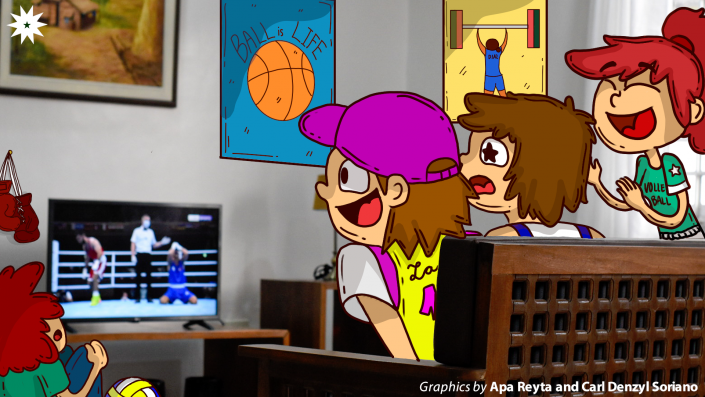
Nearly a month has passed since the Tokyo 2020 Olympics, wherein the Philippine team achieved its most historic campaign since the 1932 Los Angeles Games by garnering four podium finishes: gold for Hidilyn Diaz (weightlifting), two silvers for Nesthy Petecio and Carlo Paalam, and a bronze for Eumir Marcial (boxing), all notably coming from individual sports. The impressive bout gained much attention from the international and local crowd and served as a testament to the Filipino athletes’ talent and hard work.
However, different issues also came to light due to this impressive Olympic run. For many years, individual sports have not gotten the same recognition and support as popular team sports in the country like basketball and volleyball. This historical achievement allowed athletes to showcase the “lesser-known” sports and prove that they can also represent the Philippines in their own unique way.
Insufficient support
The impact of basketball in the country has been evident for a long time. Stadiums are always packed with spectators, and tickets are sold out for almost every game. Even some loyal fans watch games from their homes to show support.
When it comes to the sporting world, funding for equipment, transportation, and facilities is necessary for the conditioning of athletes. Take Gilas Pilipinas as an example. They are backed by Samahan Basketbol ng Pilipinas, headed by Manuel V. Pangilinan, which provides constant support in all of the team’s competitions.
Back in June 2019, Diaz struggled financially, even asking for additional sponsorships for her Olympic training. She also expressed her hesitance in reaching out for help. Still, she persevered to fulfill her longtime dream of winning a gold medal in the Summer Olympics, which ended up becoming a reality. Unlike basketball players who receive consistent funding and assistance, Diaz had to reach out desperately.
Diaz had to train in Malaysia due to the lack of facilities available in the Philippines and proceeded to lengthen her stay because of lockdown regulations. Furthermore, she pointed out the measly funds that were given to her, noting the absence of both financial and mental support for athletes.
A new direction
The sports played in the University Athletic Association of the Philippines (UAAP) and National College Athletic Association (NCAA) serve as avenues to exhibit talented players who excel in their respective sports. The fanbase and exposure these collegiate leagues bring to the world of sports are vital to an athlete’s long-term opportunities. Producing a solid foundation can lead to introducing them to the professional league or even the national team. But sports like weightlifting and boxing are not included in the collegiate level, making the audience for them limited.
However, the success of the Filipino Olympians can now encourage more exposure for their respective sports—advocating for young aspiring athletes to follow their path and opening doors to new narratives. They all look forward to adding these sports to collegiate competitions, namely the UAAP and NCAA.
Last August 31, UAAP Executive Director Rebo Saguisag shared that the league is now open to the idea of including weightlifting and boxing for future UAAP seasons. He mentioned that the only challenge is the restrictions of the COVID-19 pandemic affecting the recruitment and management of the teams. Furthermore, in living up to the principles of the UAAP, the foundation of national sports programs in the country also aims to be strengthened.
Dax Castellano, NCAA Season 97 Management Committee Chairman, also affirms that the NCAA is open to new innovations and proposals to produce more athletes who are capable of representing the country in the future. Further consultations on this matter are needed in order to discuss the idea’s feasibility.
A better outlook
The record-breaking Olympic stint garnered so much attention and produced diverse possibilities for the development of the sporting community in the country. Each Filipino Olympian became role models to the public for their groundbreaking performances. Especially the medalists, they were able to represent the several sports that lacked the spotlight they deserved while lifting up the spirit of an entire nation throughout a difficult time.
There are high hopes for the upcoming generation, as many programs and organizations involve themselves to help support Filipino athletes. With the many rising individuals like weightlifters Elreen Ando and 17-year-old Vanessa Sarno, they both yearn to become promising representatives of the Philippines in upcoming competitions.
Having the initiative to introduce more categories to the collegiate playing field is a significant step in improving the exposure of these lesser-known sports, providing athletes with a bigger platform to exhibit their passion and talent. Since the conclusion of the Summer Olympics, several companies and notable businessmen have started reaching out to the athletes, providing them with various rewards for their performance, including funds and equipment needed for training.
A promising future is in sight as there is a glimpse of establishing improved sporting programs and initiatives in the Philippines. It is essential to take advantage of every opportunity of evolving the country’s overall sporting scene, so that athletes are empowered to excel in their own careers while inspiring many people from different backgrounds to do the same. Athletes are motivated to make a name for themselves to fulfill certain aspirations in life that can redefine the country’s cultural and sporting identity.
